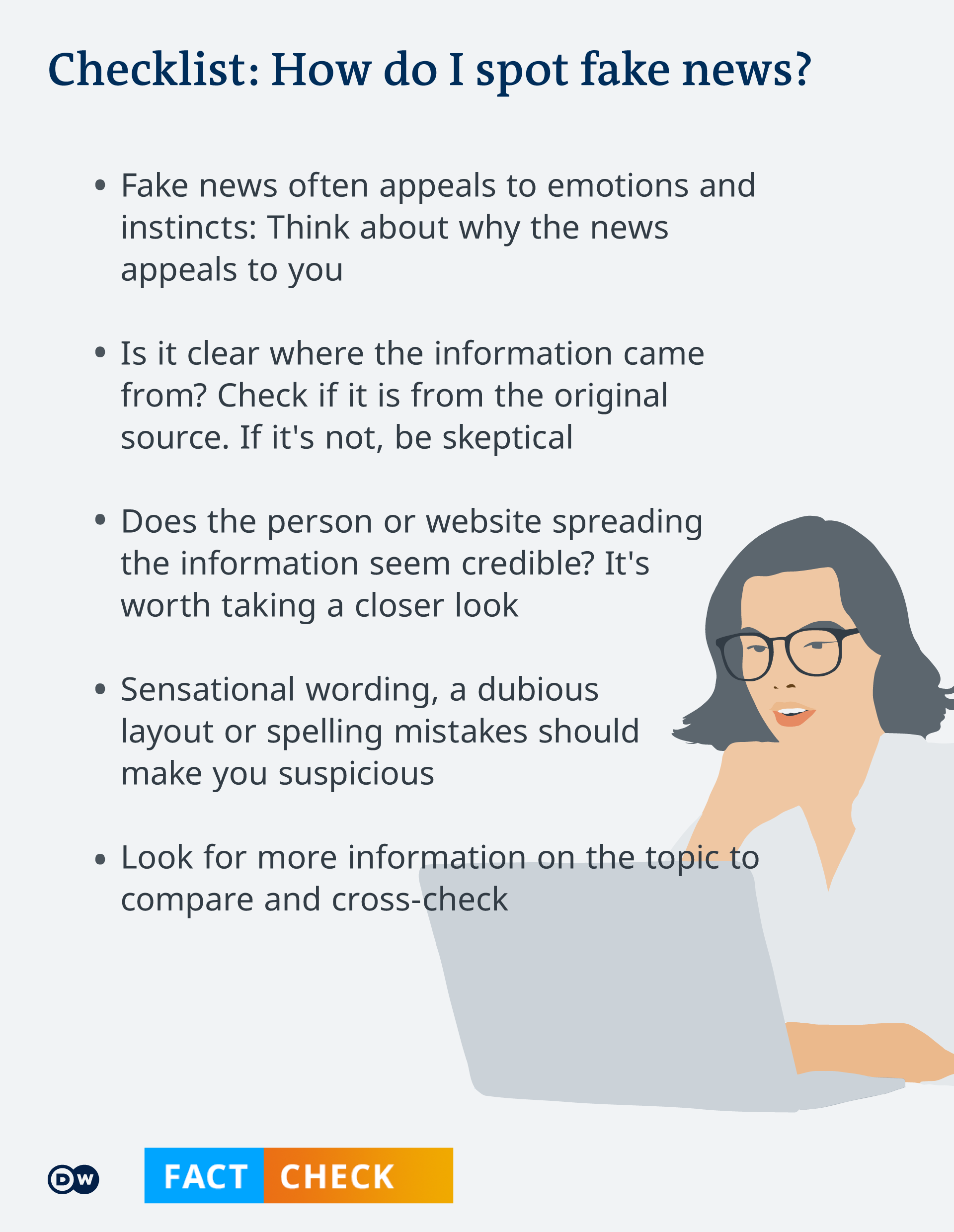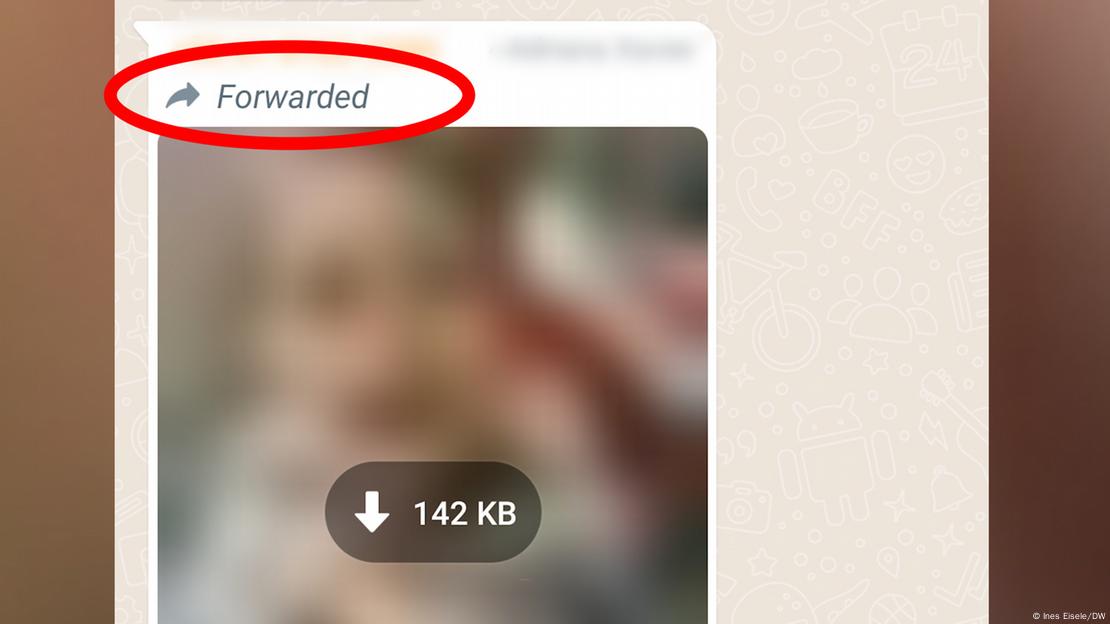Tue 06 August 2024:
Whether it’s COVID-19, climate change or migration — fake news spreads six times faster on social media than facts. But how can I identify and check fake news? Here’s some advice from DW’s fact-checking team.
In April, a screenshot of a quote from Annalena Baerbock circulated on Facebook. In it, the German Green Party leader and then-candidate for chancellor supposedly called for an end to private pet ownership because pets would consume too much CO2.
In Brazil in 2018, also during an election campaign, millions of messages were sent via WhatsApp in favor of the right-wing populist president, Jair Bolsonaro. Among other things, these messages suggested that the left-wing Workers’ Party (PT) was planning a communist dictatorship or wanted to legalize pedophilia.
During the coronavirus pandemic, videos and posts by medical professionals whose statements about the coronavirus contradicted other scientific findings have repeatedly gone viral.
What do these examples have in common? They are fake news — also known as disinformation, which is information that is partially or even completely false and deliberately disseminated to influence political views or generate as many clicks as possible.
Fake news often spreads rapidly and has become a huge problem in the digital world. Many users find it difficult to separate from credible information.
Here are some pointers on how you can counter the flood of false information. This article is primarily about fake news in written form — but DW will be publishing further articles about fake images and videos.

Be vigilant and suspicious
In the latest Digital News Report from the Reuters Institute at Oxford University, more than half of respondents said they had recently seen false or misleading information about the coronavirus. More than a quarter recalled misinformation in that context about celebrities.
Anyone who uses the internet should maintain a healthy degree of mistrust and not take everything at face value — especially on emotional and controversial topics, or something that appears to be too spectacular and comes across as lurid.
This was the case in the aforementioned alleged quote from Baerbock. She had never called for banning pets and yet many fell for the quote.
That might have been avoided if users had taken a step back and asked themselves the following questions:
- Is this an issue that triggers me perhaps because I have pets myself?
- Can I trace the origin of the quote?
- Does the information, in this case, the alleged statement by Baerbock, seem plausible?
- Could someone have an interest in spreading the news, in this case presumably to discredit Baerbock and her party?
- Are there further indications of a dubious origin, such as misspellings?
Who is behind it?
Fake news often reaches users as a post on platforms like Facebook, Twitter or Instagram. Take a close look at the account that was used to spread the news. This can reveal a lot about the person’s interests and convictions. The account could very well be run by a so-called social bot or troll. (More about this in a separate article.)
Messenger services are another way of spreading dubious information. Take the WhatsApp messages mentioned earlier that were used to bombard Brazilians during the 2018 election campaign. According to the newspaper Folha de S. Paulo, Brazilian companies had ordered internet service providers to send mass messages in favor of Bolsonaro. The recipients’ cell phone numbers came from the right-wing populist’s election campaign and third-party providers.
If you receive content through messenger services, you can ask the sender where they got the info. More often than not, the person will have forwarded it without questioning the veracity or origin themselves.

The issue of forwarded fake messages is becoming increasingly troublesome. As a result, WhatsApp introduced some changes. A small arrow above a message indicates that this message has been forwarded to you (see screenshot). Two arrows on top of each other show that this message already went through a chain of at least five chats until it reached you. If messages have already been shared so many times, they can only be forwarded with restrictions. In some countries, such messages are marked with a small magnifying glass. You can use that to call up the Google search function with the text of the message.
If the message contains a link, you can also check which media or other pages it leads to. A link within a message does not necessarily mean that the information is correct. There are websites that are unscrupulous about journalistic principles and rely on dramatization and exaggeration for the sake of generating as many clicks as possible.
You may also discover that you have landed on a state-controlled site, a private blog or even a site containing satirical content. You should look out for a publishing disclosure claiming editorial responsibility. And a number of countries require a legal notice for any commercial offer. Also, keep an eye out for text errors, excessive advertising and unprofessional-looking layout.
Let’s take a look at the website World News Daily Report as an example. Visually, the site looks modern and professional. But the focus seems to be mainly on peculiar and bizarre incidents. For example, a ship that disappeared in the Bermuda Triangle turns up years later in the Sahara; a hairdresser ends up in jail for making voodoo dolls from his customers’ hair. According to another text on the site, a brother and sister from New Jersey are allowed to marry after a 10-year legal battle.
Only a closer look reveals that this is a website dedicated to satirical content. The portal’s logo reads “World News Daily Report — Where facts don’t matter.” If you scroll to the very end of the website, you will find further explanation that everything on the site is fictitious.

A word of warning: There may also be attempts lurking behind unknown links to grab your data for fraudulent purposes. If you are asked to enter passwords or personal data in an inappropriate place, it could be a so-called phishing site, a fake site.
Are the claims true?
It’s crucial to diligently examine the actual content of a post, a forwarded message or any other text. Are the claims or images coherent and realistic?
To find out more about the topic or issue in question, you can use search engines to research what else is being reported. If, for example, a politician has made a memorable statement or something groundbreaking has happened, other trustworthy media will have picked it up. Their articles are usually best found on search engines under the “News” tab. You can also change search options such as the publication period or language.

The pages of official bodies and recognized institutions are also a good place to start to find credible information. For example, the World Health Organization and the Robert Koch Institute are far better sources for coronavirus-related content than YouTube videos posted by individual medical professionals. Even if they are experts in their field, it’s possible such people are voicing individual opinions, do not have a complete overview, or are even coronavirus deniers.
If there are specific references to the origin of the information in the news item you want to check — such as a particular study, a party program or a speech — then, if possible, look up the original to check what has been said there. Sometimes quotes are abbreviated or taken out of context, giving them a different meaning.
There are also various websites dedicated to clearing up fake news and separating fact from fiction. In German-speaking countries, these include Correctiv, Hoaxsearch and also Deutsche Welle . Reliable international websites include FactCheck.org, Snopes and Full Fact.
__________________________________________________________________________

https://whatsapp.com/channel/0029VaAtNxX8fewmiFmN7N22
__________________________________________________________________________
Do not forward everything
As an internet user, you can act to counter the negative influence of fake news by not simply forwarding what has been sent to you without exercising your own due diligence. Misinformation is not necessarily forwarded out of malicious intent or a certain conviction, but rather out of a lack of attention or because it’s driven by strong emotions.
If in doubt about where the information comes from and how credible it is, don’t pass it on. Instead, talk to the person who’s sent it about your concerns. You can also report suspected false news to the platform operators and/or a fact-checking website.
This article originally published in DW Click here

______________________________________________________________
FOLLOW INDEPENDENT PRESS:
WhatsApp CHANNEL
https://whatsapp.com/channel/0029VaAtNxX8fewmiFmN7N22
![]()
TWITTER (CLICK HERE)
https://twitter.com/IpIndependent
FACEBOOK (CLICK HERE)
https://web.facebook.com/ipindependent
YOUTUBE (CLICK HERE)
https://www.youtube.com/@ipindependent
Think your friends would be interested? Share this story!





